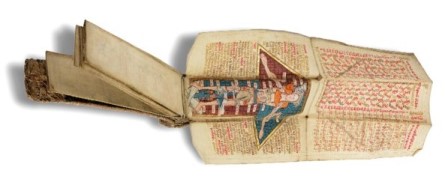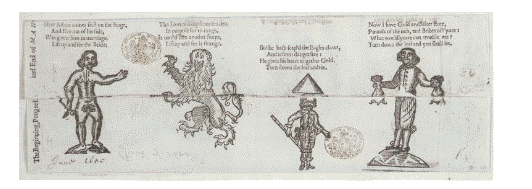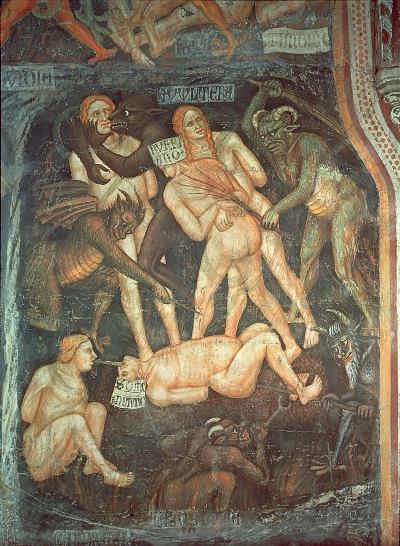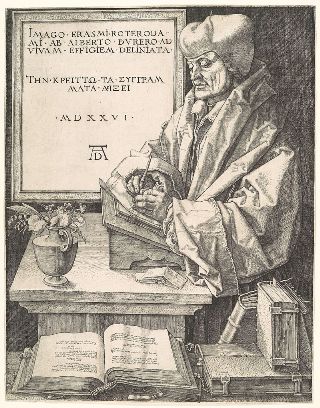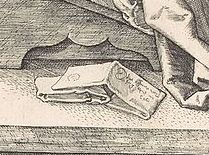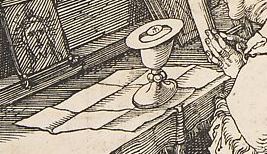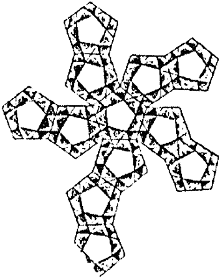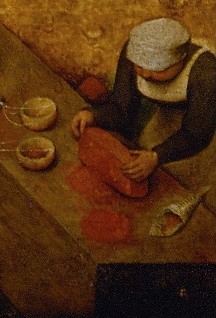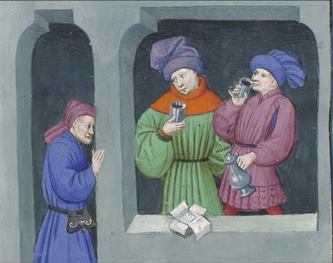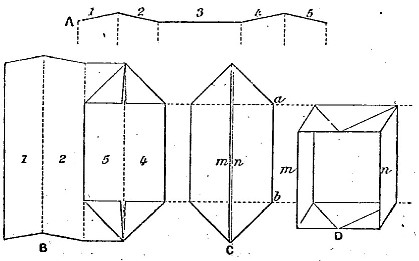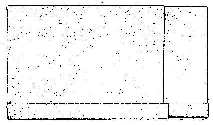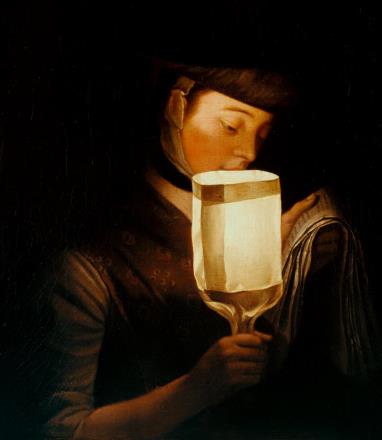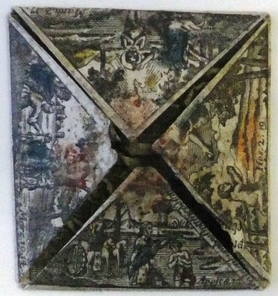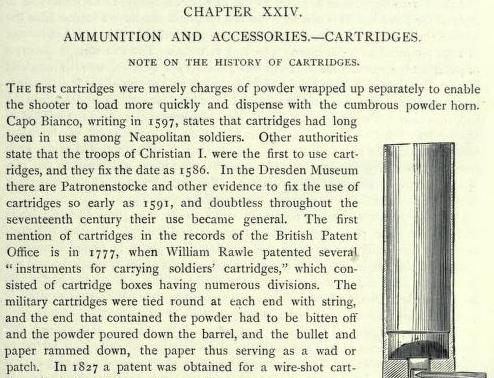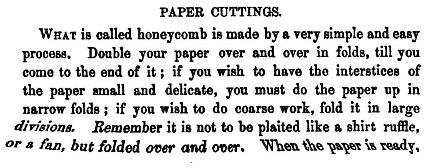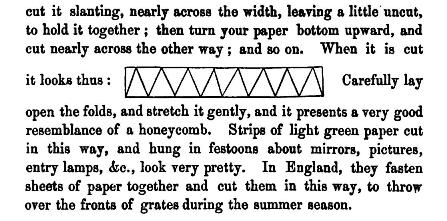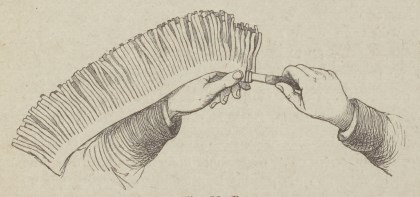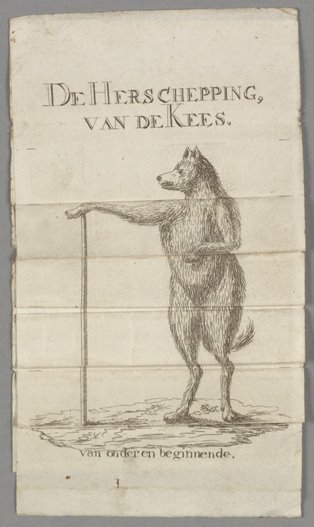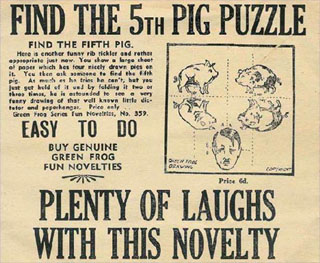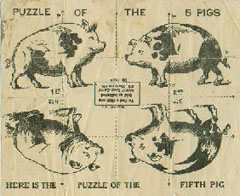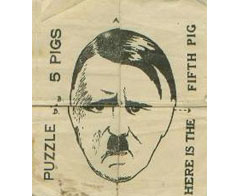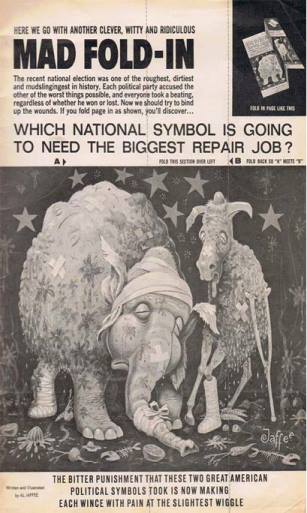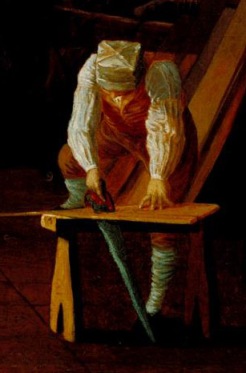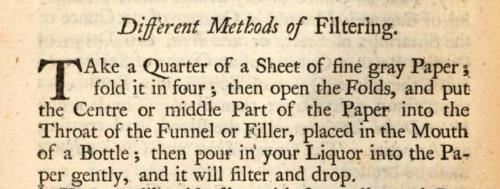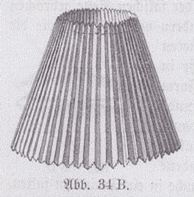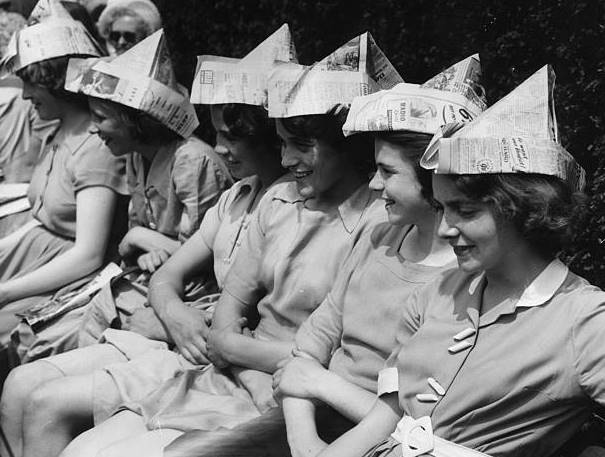| The Public Paperfolding History Project
Last updated 26/2/2024 x |
|||||||
| A Brief History of Practical Paperfolding in Europe and the Americas | |||||||
In most cases the sections on this page only give information about the earliest known example(s) of the type of practical paperfolding being referred to. Further information can be accessed through the links. ********** The word 'book' can refer to documents written or printed on lengths of papyrus, parchment, vellum or paper rolled up into scrolls or folded into zigzag form, to codices made by binding together large sheets folded into smaller pages, or to other more esoteric forms. Books can contain pages which fold out to become larger than the normal page size. Pages can also be enhanced with folding flaps or three-dimensional pop-up additions. ********** i. Codices Codices were originally made by binding together sheets of parchment or vellum. I have not been able to establish the date at which the transition to the use of paper pages was made or identify the earliest paper codex. This does not seem to be a topic in which scholars have interested themselves. It is quite conceivable that this transition was first made in the Islamic world. ********** ii. Zigzag Books Information about this topic will be added in due course ********** iii: Bat Books Bat books are books which hang upside down from the belt and whose pages can be unfolded like wings. The term 'bat book' was coined by the German scholar J P Gumbert, who published a catalogue of all known examples, some 63 in all. There are generally only 6 to 8 pages in a bat book and they are linked together by tabs at the foot of each page. The pages are not paper but parchment or vellum. The pages are generally folded into half downwards to reduce the height and then either into thirds or quarters sideways to reduce the width. The oldest extant example was made at Glastonbury Abbey around 1265 and lists relics and place names of the area. The most well-known type of bat books are medical almanacs fron the 13th to 15th centuries, one of which is illustrated below.
********** iv. Harlequinades / Metamorphoses Harlequinades / Metamorphoses are a kind of book with flaps to the top and bottom of the page which can be folded in and out as the directions for the story require. These books often have Harlequin as the central character, hence the alternative name Harlequinade. The two earliest known Metamorphoses were both published in 1650.
********** iv. Fold-out pages Information about this topic will be added in due course ********** v. Pop-up additions to pages Information about this topic will be added in due course ********** Mitres of Infamy were a primitive form of paper hat that people were made to wear as a form of public humiliation. They were usually decorated with a description of the person's offences. This detail from 'The Last Judgement' by Taddeo di Bartolo, painted c1394, for instance shows adulterers wearing Mitres of Infamy.
These hats are not the same as, but are related to, the capirotes or corozas which the Spanish Inquisition imposed on their victims, which were also sometimes made of paper. They may also have been the ultimate source of Dunce's Hats. ********** i. The Basic Letterfold Scholars have not generally interested themselves in the way in which letters are folded and most databases of early letters do not contain a field for the folding method. It seems likely, however, that most early letters were folded by the method shown in an engraving of Erasmus of Rotterdam by Albrecht Durer dated 1526. In this method the two long edges of a rectangular sheet of paper are folded inwards to create a double-layered, thinner, rectangle. One end is then bent over and tucked inside the other, and the whole flattened into a package. If the package is flattened so that the join is arranged in the centre (or thereabouts) it can easily be sealed with wax. This kind of letterfold continued in use until the widespread adoption of envelopes in the19th century.
********** ii. Paper Poulets A Paper Poulet, is a kind of folded love note which seems at some point during the folding (or unfolding) to have resembled the two wings of a chicken. Unfortunately, we do not know how these Paper Poulets were folded. The earliest known reference to a 'poulet' in this sense is from an uncomplementary popular song, said to date from 1596, about Marie de Guise (later Queen of Scotland) which suggested that she 'loves paper poulets as much as (poulets) in fricasee' ('aimoit bien autant les poulets en papier qu'en fricasee)'. There is also a reference to a poulet, in the sense of a kind of love note, in Moliere's play 'L'Escole des maris' which was first performed in 1661. ********** As far as I know, the first mention that it is possible to cook in a paper pan occurs in the manucript 'De Viribus Quantitatis' by Luca Pacioli which dates to between 1496 and 1508. ********** E: Corporals A corporal is a rectangular cloth placed on the altar during mass, below the communion chalice. They were commony folded into thirds in both directions, as shown in Albrecht Dürer's engraving of the 'Mass of St Gregory' which dates from 1511.
Detail from Dürer's 'Mass of St Gregory' ********** F: Mathematical paperfolds i. Constructing Accurate Right Angles by Folding Paper 'De Viribus Quantitates' by Luca Pacioli, which dates to between 1496 and 1508, gives a method of constructing an accurate right angle, without using compasses, by folding a sheet of paper twice. ********** ii. Cut and Fold Polyhedral Models According to Max Stech in his book 'Dürers Gestaltlehre der Mathematik und der bildenden Künste (Dürer's Gestalt Theory of Mathematics and the Fine Arts), published by Halle an der Saale in 1948, a 1509 Venetian edition of 'Divina Proportione' by Luca Pacioli and illustrated by Leonardo da Vinci contains a drawing showing the foldable net of a regular dodecahedron. (Information from 'A History of Folding in Mathematics by Michael Freedman, published by Birkhauser in 2018.)
********** iii. Globus Gores Onomatologia curiosa artificiosa et magica oder ganz natürliches Zauber-lexicon', which was published in 1759, contains a section explaining how to cover a ball with paper using the Globus Gores technique. ********** G: Packets and Packaging A Grocer’s Cone, presumably made from paper, although there is no text to confirm it, appears in the famous painting 'Children's Games' by Peter Bruegel the Elder which dates to 1560.
Detail from 'Children's Games' by Peter Bruegel the Elder ********** The Decameron Box A picture in an illustrated version of 'The Decameron' by Boccacio, now held in the library of Arsenal, in Paris, and dateable to 1432, depicts a white coloured box, which looks very much as though it is folded from paper. But is it? There is no text to tell us.
Detail from an illustration in 'The Decameron' by Boccacio ********** The magnificent Flemish illustrated manuscript known as The Hours of Catherine of Cleves, which dates to 1440, contains several illustrations of a sophisticated cut-and-fold box at the bottom of a page devoted to St Agatha. The pictures clearly show how the box is constructed but there is no textual evidence of the material used. In the 19th century this design also became popular as a recreational paperfold. Pge devoted to St Agatha in 'The Hours of Catherine of Cleves' ********** In the early 1990's a large number of rodent-chewed Hexagonal Packets containing seeds were discovered in the attic of The Woodlands, a historic estate in Philadelphia, once owned by the botanist William Hamilton (1735–1840). Some of these bear dates. The example pictured below is dated 1803.
********** Simple paper boxes folded from oblongs had probably been used as cases for the cooking of cakes and pastries for many years, but the earliest definitive evidence for this practice does not appear until 1889, when a design for such a box, now usually known as the Patisserie Box, appeared in 'La Science Pratique' by Gaston Tissandier. The text notes that this box is 'employe par les confiseurs' (used by confectioners).
********** A simpler, rectangular design was explained in 'La Ensenanza del Trabajo Manuel' by Pedro de Alcántara García and Teodosio Leal y Quiroga, which was published in Madrid in 1903, where it is described as 'the bag so useful in pharmacies', now sometimes called the Apothecary's Packet. This design is also, probably, of much greater age.
********** H: Fireworks I have not made a study of the earliest mentions of rolled and folded paper being used to make fireworks, but there is information, for instance, in 'Pyrotechnia, or a discourse of Artificiall Fire-works: In which the true Grounds of that Art are plainly and perspicuously laid down' by John Babington, which was published in London in 1635. ********** In describing how to fold Troublewit, the author of 'Sports and Pastimes', which was published in London in 1676 gives instructions which rely on the reader having a knowledge of how to make a pleated paper lantern, 'then pinch it a quarter of an inch deep, in the manner as you pinch a paper Lanthorn, that is in pleats like a ruff ...' and 'In the fashion of a dark Lanthorn' and 'In the fashion of a Lanthorn with a rose at each end ...' A much simpler kindof paper lantrn is depicted in this painting by Henry Robert Morland (1716–1797) known as 'A girl singing ballads by a paper lanthorn', which is said to date from between 1765 and 1782.
********** J: Patenbriefs Patenbriefs were an informal record of the birth of a child which were often folded into packets and used to envclose gifts of money given to a child by their godparents. They are also known as Göttelbriefs and Taufbriefs. Three types of folded Patenbrief are known: 1, Those printed on oblong paper and folded into a rectangular packet (evidenced from 1698 though possibly earlier) 2, Those printed on square paper and folded into a double blintz form (evidenced from 1757 though possibly earlier). 3, Those printed on square paper and folded into the form of a puzzle purse (evidenced from 1805 though possibly earlier).
A doubly blintzed Patenbrief from 1763 It has been theorised that recreational paperfolding designs such as the Double boat and the Cocotte / Pajarita were developed from the doubly blintzed form of Patenbrief. However, this seems unlikely, since Patenbriefs were not toys but valuable mementos, intended to be carefully kept and referred to for moral instruction, presumably in adolescence, and children were unlikely to have been allowed to play with them. ********** The information about the early history of Paper Cartridges that is often quoted on the internet comes from 'The Gun and its Development' by W W Greener which was first published in London in 1881. The information shown below is taken from page 589 of the 1910 Ninth Edition.
Note that this does not specifically say in every case that these cartridges were folded from paper, although that seems to be implied. ********** L: Fold, Slit and Fold designs Designs of this type are made by first folding the paper, or card, in half, in zigzag fashion, or by rolling it up and flattening the roll, then cutting one or more slits into one or both edges. The paper is then opened out and folded again (though often this folding is only minimal) to produce the design. This method is used, for instance,to make the little paper ruffles, or manchettes, that were used to decorate the ends of joints of meat, and which are, for instance, mentioned in the American periodical Godey's Lady Book of December 1835 in a story entitled 'Mrs. Allington's Pic Nic'.
The same method was also used to make ‘bobeches’, or drip-catchers, for candles. ********** ii. Stove Covers 'The Girl's Own Book' by Lydia Marie Child, which was published by Clark Austin and Co in New York in 1833 contains a design made by rolling and slitting paper and the interesting information that 'In England, where they burn coal more than they do here, they fasten sheets of paper together and cut them in this way, to throw over the front of stoves during the summer season.'
********** iii. Paper Tinsel 'Des Kindes Erste Beschaftigungsbuch' by E Barth and W Niederley, which was published in 1876, contained instructions for making paper tinsel in a similar way.
********** M: Paper Spills Spills made of folded paper were used to carry flame from a fire in order to light the wicks of candles or oil lamps. Prior to the easy availability of cheap matches this would have been the main way in which candles or oil lamps were lit. The earliest reference I have found to this practice is in the 'American Girl's Book or Occupation for Play Hours' by Eliza Leslie, which was published in Boston and New York in 1831.
********** N: Paperfolding as Political Propaganda Paperfolding has been used as political propaganda in several ways: By the use of images of well known paperfolds in satirical cartoons, specifically the Cocotte / Pajarita and the Newspaper Hat . Many examples of this can be found in the pages devoted to these paperfolds. In the use of Newspaper Hats as election campaign promotional items. An example of this dating from 1896 can be found here. By the production of novelty paperfolds which convey a propaganda message. ********** i. Zigzag Folded Multi-image Pamphlets These folds of these pamplets could be rearranged to produce a second image. Several were produced, for instance, between 1780 and 1787 as propaganda for the Patriotic cause during the years of the Pattriottentijd rebellion in the Netherlands.
********** ii. The Fifth Pig This fold-in design in which four pigs turn inro a picture of a fifth, for instance Adolph Hitler or Mussolini, was much used as a propaganda tool by the Allies during the Second World War, but dates back to at least 1870/1 , and possibly much earlier.
********** Issue 86 of Mad magazine, published in 1964, featured an innovative inside back cover illustration by Al Jaffee which was designed so that the picture folded inwards in a zigzag fashion to reveal another picture, with a satirical connection between the two. These 'Fold-ins' became a regular feature of the magazine. Some of these fold-ins, such as the one shown below, which is from April 1965, were overtly political in nature.
********** O: Envelopes Information about this topic will be added in due course ********** P: Paper Bags Information about this topic will be added in due course ********** Q: Cardboard Packaging There are two claims for earliest commercial use of cardboard packaging, both from 1817: According to 'A History of Packaging' by Paula Hook and Joe E. Heimlich 'The first commercial cardboard box was produced in England in 1817'. Wikipedia attributes this manufacture to the firm of M. Treverton & Son. According to 'Exploring Package Design' by Chuck Groth 'The oldest existing cardboard box package design was produced in Germany for a board game called 'The Game of Besieging,' in 1817.' *********** R: Greetings Cards Information about this topic will be added in due course ********* D: Book Covering Information about this topic will be added in due course ********** T: Parcel Wrapping Information about this topic will be added in due course ********** U: Gift Wrapping Information about this topic will be added in due course ********** V: Christmas Crackers According to Wikipedia and other sources, Christmas Crackers were invented in 1847 by London-based confectioner and baker Tom Smith (1823 – 1869) and were based on the French 'bon bon', a sugared almond wrapped in a twist of tissue paper. ********** W: Dust Jackets According to Andrea Koczela (See A Brief History of the Dust Jacket) 'The modern-style dust jacket was first introduced in the 1830s--although possibly earlier (evidence is inconclusive). Featuring flaps, it was a much-improved design. These dust jackets could remain on the book when it was opened, providing protection for volumes even as they were read.' ********** The earliest definitive evidence for the Workman's Hat, a folded paper hat developed from a waterbomb base, which could easily be sized to fit any individual head, comes from an oil painting by John Hill which can be dated to around 1800. Such hats became popular, although not ubiquitous, for many trades during the 19th century in England.
Detail from 'Interior of the Carpenter's Shop at Forty Hill, Enfield' by John Hill ********** A method of making a paper filter appears in 'Select Transactions of the Honourable The Society of Improvers', which was published in Edinburgh in 1743.
********** A design for a very basic pleated pleated paper lampshadeappears in 'Des Kindes Erste Beschaftigungsbuch' by E Barth and W Niederley, the foreword of which is dated October 1876.
********** AA: Paperfolding in Advertising The earliest use of paperfolding in advertising that I know of is a leaflet printed on both sides of a square sheet of paper, which would once have been folded into a triple blintz form. It could then be unfolded, in stages, to reveal the advertising material inside. This leaflet can be dated to the late 18th / early 19th century.
********** BB: Newspaper Hats used as Sun Hats In England in the 20th Century Newspaper hats were frequently used as ad hoc sun hats. This became a particular feature of hot days at the Wimbledon Lawn Tennis Championships. Photo taken at Wimbledon in 1953.
********** CC: Modern Everyday Practical Paperfolds This section has been added to allow me to include a few modern practical everyday paperfolds for which I have otherwise found no reference in the literature and therefore do not know how old the practice is. i. Dog-earing I do not know when the practice of dog-earing (folding over the coner of a page to mark the place in a book) began. ********** ii. Weakening and tearing Paper is frequently weakened by folding so that it can be torn into smaller pieces along the fold lines. ********** iii. Paper Wedges Paper wedges were (perhaps still are) frequently folded in order to be used to stop wonky furniture, particularly tables, from rocking or to hold doors open. ********** iv. Place cards and information cards Small cards that have been simply folded inhalf then allowed to partly re-open are often used as place cards at weddings or training events. Similar cards, sometimes folded into a complete triangle, are also used, for instance in hotel rooms, to convey information to guests. ********** |
|||||||
